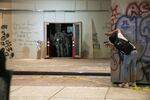Portlanders have turned out to protest systemic racism and police brutality for more than 50 consecutive nights on downtown Portland streets.
While some journalism organizations, including OPB, haven’t been able to send reporters out on a nightly basis, independent freelance journalists are on the ground covering the chaos nearly every night.
Tuck Woodstock and Sergio Olmos are two Portland-based journalists who have been covering protests since late May.
They joined OPB’s “Think Out Loud®” to reflect on nearly two months of ongoing protest coverage.
Covering these protests is inherently dangerous: law enforcement's use of tear gas, impact munitions, pepper balls and other sanctioned violence against protesters and the press are well-documented.
OPB first reported that federal law enforcement officers have been using unmarked vehicles to abduct protesters off Portland streets.
The nightly grind of reporting comes at a critical time as federal officers have escalated their use of aggressive tactics upon protesters.
“Those federal officers, when they do dispersals — some of them carry assault rifles, some of them are aiming handguns ... with live ammo at crowds,” Olmos said.
“They are out there tear gassing entire city blocks and then they retreat inside the courthouse. You can’t ask them anything.”

Protesters demonstrate against racism and police violence in front of the Mark O. Hatfield federal courthouse on July 12, 2020. Earlier in the night, federal law enforcement officers shot a demonstrator in the head with a less lethal impact munition, causing severe injury.
Jonathan Levinson / OPB
Reporters covering the protests are heading out with protection: some have helmets and gas masks; others wear Kevlar or chest plates to defend themselves from impact munitions, all the while performing their jobs as lawful observers.
But without institutional backing from major media outlets, freelance reporters witness protests each night — sometimes staying out until 2 or 3 a.m. — with no promise of getting paid or compensated.
“This work is being done mostly by freelancers with no health insurance. They come back home, and there’s nothing on the horizon for getting paid for any of this,” Olmos said.
“There've been nights where I come home absolutely devastated — tear-gassed, pushed around. I’m mentally at my limit. And [then] somebody sends me like $5 on Venmo, and I just want to cry and think, ‘Alright, I’m good.’ I’ll go back the next day.”
Tears as I hear @MrOlmos and @tuckwoodstock talking about being freelancers with no pay, no benefits, no backing as they provide 54 days of coverage here in Portland protests. You have to love journalism to be a freelancer. You can’t understand unless you do it.
— Leah Sottile (@Leah_Sottile) July 21, 2020
“I have been at protests, watched what happened with my eyes, filmed it and gone home — and [then] see Portland police report a completely different thing from what actually happened,” Woodstock said.
“So it’s just really important for me, as someone who considers themselves to be a professional, objective journalist to say this is actually not factually true. That’s really important to me.”
Hear the full conversation by clicking play on the audio player at the top of this story.